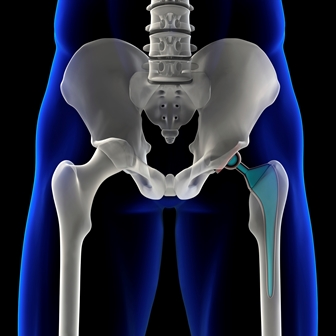Canada’s health technology assessment (HTA) organizations provide Canadians with independent, evidence-based information on drugs and other health technologies. HTA allows decision-makers to balance the potential benefits of new drugs, devices, or procedures with the need to get the best value out of every health care dollar. CADTH — with its Rapid Response service — is a leader in providing timely, credible, and relevant evidence to support informed decision-making. Here is a round-up of recent rapid evidence reviews from CADTH focusing on hip replacement surgery from our Rapid Response service.
Total hip replacement is a common orthopedic procedure for patients with degenerated hips and chronic pain. In 2009-2010 in Canada, 13,068 patients underwent the procedure. During total hip replacement, the head of the femur is removed and replaced with a prosthesis that has a protruding ball. The ball fits into an acetabular cup that is secured to the pelvis, and the cup may be lined to reduce friction and wear.
Hip resurfacing arthroplasty is another option for treating patients with degenerative hip disease. During hip resurfacing, a metal cap is placed on the femoral head to cover damaged bone, and a metal shell is placed in the acetabulum.
MORE: SELF MONITORING OF BLOOD GLUCOSE IN TYPE 2 DIABETES
The cups, balls, and cup liners of hip prostheses used for total hip replacement are made of various combinations of metal, ceramic, or polyethylene. For metal-on-polyethylene hips, the ball is made of metal and the cup is lined with polyethylene. Metal-on-metal hips have a ball and cup both made of metal, with or without a metal liner. Metal-on-polyethylene hips – the gold standard – typically last 10 to 15 years or more, but wear and bone loss can be issues for younger, more active patients. Metal-on-metal hips tend to have better wear rates but may erode and gradually release metal ions into the bloodstream, which has been associated with high failure rates and surgical revisions.
CADTH’s Rapid Response service looked at the evidence comparing total hip replacement with hip resurfacing, and comparing metal-on-metal with metal-on-polyethylene hip prostheses. The review showed no significant differences in mortality, dislocation, or deep hip joint infection between total hip replacement and hip resurfacing. When assessing bone preservation, wear rates, and functional outcomes, however, hip resurfacing performed better; but metal-on-metal hip resurfacing resulted in higher rates of revision, femoral neck fractures, and component loosening than total hip replacement. The evidence review also revealed a lack of both clinical and cost-effectiveness evidence on total hip replacement using metal-on-metal prostheses compared with metal-on-polyethylene prostheses.
A second related rapid evidence review by CADTH looked more closely at the components and materials used for total hip replacement. This review recognized that there are several designs of hip implants available and different materials used for the implant components. Modular hip implants, unlike standard models, allow for the choice of different femoral neck lengths and femoral head sizes as well as modular acetabular cups. This review found that ceramic-on-polyethylene implants do not appear to be more effective than metal-on-polyethylene implants for total hip replacement, but that ceramic-on-ceramic implants may require fewer revisions after five years than metal-on-polyethylene implants. Modular stem implants may have lower early survival than standard implants but may be equal or better than standard implants over the long term. Large femoral head implants for total hip replacement are likely beneficial compared with standard-sized implants.
MORE: ANTI-INFLAMMATROY DRUGS: WHAT’S THE EVIDENCE
A third rapid evidence review on hip replacement focused on the polyethylene liners of the acetabulum cups for metal-on-polyethylene hip prostheses. Alternatives to regular polyethylene liners include cross-linked polyethylene and newly developed vitamin E-infused polyethylene liners. The CADTH rapid review compared the evidence on the different polyethylene liners and found that cross-linked polyethylene liners performed better than regular polyethylene liners, with reduced wear rate, bone loss, and need for revision. But there was no evidence comparing vitamin E-infused polyethylene liners with regular or cross-linked liners.
This series of Rapid Response reviews from CADTH demonstrates just how complex decisions about health technologies can be. The initial question asked about the type of procedure to undertake, subsequent questions involved the type of hip prosthesis to use, then focused on what the prosthesis is made of, right down to the type of polyethylene lining the acetabulum cup!
HTAs such as CADTH’s Rapid Response reports can’t answer all the questions that arise in the treatment of degenerative hip disease. But they can go a long way in providing the evidence pieces to the treatment puzzle. Clinicians, policy-makers, patients, and others involved in making important decisions in health care in Canada can access our Rapid Response reports free of charge on our website anytime at www.cadth.ca/RapidResponse.


